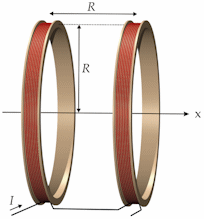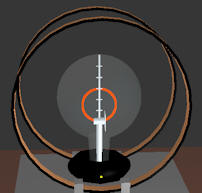Electron motion in a magnetic field
Apparatus to determine the electron charge to mass ratio (e/m)
Apparatus description
In the e/m apparatus electrons are accelerated through a potential difference
V (200 V - 300 V) in a spherical tube filled with helium gas at a low pressure of 10-2 mm H.
 In the
tube a filament (the cathode) is heated and emits electrons which are accelerated by
the potential difference V between the cathode and the anode (ground). A beam of electrons emerges through a hole
in the anode. A grid can help to focus the electron beam.
In the
tube a filament (the cathode) is heated and emits electrons which are accelerated by
the potential difference V between the cathode and the anode (ground). A beam of electrons emerges through a hole
in the anode. A grid can help to focus the electron beam.
The accelerating voltage V determines the kinetic energy and therefore the speed
v of the electrons. The electron beam leaves a visible trail in the tube,
because some of the electrons collide with helium atoms. The atoms are
excited and then radiate visible light.
 A pair of
Helmholtz coils produces a nearly uniform magnetic field in the regions of the
spherical tube. Helmholtz coils are two coils with radius R are separated
by the same distance R. When the coils are connected so that the same
current flows through both coils in the same direction, the Helmholtz coils
produce a region with a nearly uniform magnetic field near the center
of the coils. The Helmholtz coils of the e/m apparatus have
a radius and a separation of R = 15 cm. The magnitude of the magnetic field
B produced by these coils is proportional to the
current I flowing through the coils. B = (7.56*10-4 T/A)
* I. The direction of B is
perpendicular to the plane of the coils.
A pair of
Helmholtz coils produces a nearly uniform magnetic field in the regions of the
spherical tube. Helmholtz coils are two coils with radius R are separated
by the same distance R. When the coils are connected so that the same
current flows through both coils in the same direction, the Helmholtz coils
produce a region with a nearly uniform magnetic field near the center
of the coils. The Helmholtz coils of the e/m apparatus have
a radius and a separation of R = 15 cm. The magnitude of the magnetic field
B produced by these coils is proportional to the
current I flowing through the coils. B = (7.56*10-4 T/A)
* I. The direction of B is
perpendicular to the plane of the coils.
 The e/m tube has a radius of 7.5 cm. If the tube has not been rotated,
B is perpendicular to the
electron beam velocity and deflects the electron
beam into a circular path. The diameter of this circular path can be measured using
the calibration marks in the center of the tube, which are equally spaced by 2 cm.
In the picture on the right the diameter of the circular path is 6 cm.
The e/m tube has a radius of 7.5 cm. If the tube has not been rotated,
B is perpendicular to the
electron beam velocity and deflects the electron
beam into a circular path. The diameter of this circular path can be measured using
the calibration marks in the center of the tube, which are equally spaced by 2 cm.
In the picture on the right the diameter of the circular path is 6 cm.
The e/m tube can also be rotated by up to 10o, allowing the electron beam
velocity to make an angle between 0 to 10o with the magnetic field.
The vector nature of the magnetic force on a moving charged particles can
therefore be explored.
Apparatus controls
- Use the mouse. Click the table to rotate the view.
- Move the mouse wheel to zoom in and out.
- Click the on/off switch to turn the power supply on and off. It
takes a moment for the filament to heat up and the electron path to become
visible.
- Click the current knob (A) and move the mouse horizontally across it to adjust the
coil current (0 A - 4 A).
The magnitude of the magnetic field B in the region of the electron tube is
proportional to the coil current I.
B = (7.56*10-4 T/A)*I.
When facing the control panel of the apparatus, the current I flows
clockwise through the coils and the magnetic field points from the front side to the back side
of the apparatus.
- Click the voltage knob (V) and move the mouse horizontally across it to adjust the
voltage (200 V - 300 V).
- Click the black ring holding the tube and move the mouse horizontally across
it to
rotate the tube up to 10o in either direction.
- always release the mouse button after an operation.
Analysis of an e/m measurement
The magnetic force Fm acting on a charged particle of
charge q moving with velocity v in a magnetic field
B is given by
the equation
Fm = qv × B.
If the
electron beam velocity is perpendicular to the magnetic field, we have
the following equation relating the magnitudes Fm, q, v, and B.
Fm = qvB.
The electron is moving in a circular path of radius r, with the magnetic
force being equal to the centripetal force mv2/r. We therefore have
qvB = mv2/r or q/m = v/Br.
We denote the magnitude of the charge q of the electron by e and therefore
have e/m = v/Br.
The electrons are accelerated by the accelerating potential
V, gaining kinetic energy equal to their charge times the accelerating
potential.
Therefore eV = ½mv2.
The velocity of the electrons
is v = (2eV/m)½. I
nserting this expression for v in the
equation above and squaring both sides we obtain
e/m = 2V/(Br)2
or 2V = (e/m) (Br)2.
The slope of a plot of 2V versus (Br)2 is equal to electron charge to
mass ration e/m.
 In the
tube a filament (the cathode) is heated and emits electrons which are accelerated by
the potential difference V between the cathode and the anode (ground). A beam of electrons emerges through a hole
in the anode. A grid can help to focus the electron beam.
In the
tube a filament (the cathode) is heated and emits electrons which are accelerated by
the potential difference V between the cathode and the anode (ground). A beam of electrons emerges through a hole
in the anode. A grid can help to focus the electron beam. A pair of
Helmholtz coils produces a nearly uniform magnetic field in the regions of the
spherical tube. Helmholtz coils are two coils with radius R are separated
by the same distance R. When the coils are connected so that the same
current flows through both coils in the same direction, the Helmholtz coils
produce a region with a nearly uniform magnetic field near the center
of the coils. The Helmholtz coils of the e/m apparatus have
a radius and a separation of R = 15 cm. The magnitude of the magnetic field
B produced by these coils is proportional to the
current I flowing through the coils. B = (7.56*10-4 T/A)
* I. The direction of B is
perpendicular to the plane of the coils.
A pair of
Helmholtz coils produces a nearly uniform magnetic field in the regions of the
spherical tube. Helmholtz coils are two coils with radius R are separated
by the same distance R. When the coils are connected so that the same
current flows through both coils in the same direction, the Helmholtz coils
produce a region with a nearly uniform magnetic field near the center
of the coils. The Helmholtz coils of the e/m apparatus have
a radius and a separation of R = 15 cm. The magnitude of the magnetic field
B produced by these coils is proportional to the
current I flowing through the coils. B = (7.56*10-4 T/A)
* I. The direction of B is
perpendicular to the plane of the coils. The e/m tube has a radius of 7.5 cm. If the tube has not been rotated,
B is perpendicular to the
electron beam velocity and deflects the electron
beam into a circular path. The diameter of this circular path can be measured using
the calibration marks in the center of the tube, which are equally spaced by 2 cm.
In the picture on the right the diameter of the circular path is 6 cm.
The e/m tube has a radius of 7.5 cm. If the tube has not been rotated,
B is perpendicular to the
electron beam velocity and deflects the electron
beam into a circular path. The diameter of this circular path can be measured using
the calibration marks in the center of the tube, which are equally spaced by 2 cm.
In the picture on the right the diameter of the circular path is 6 cm.